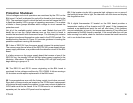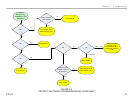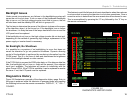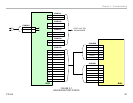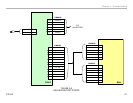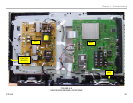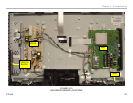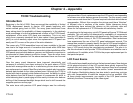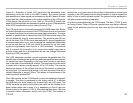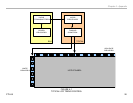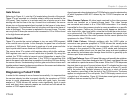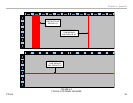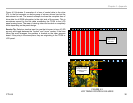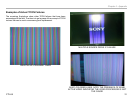
CTV-68 24
Chapter 4 – Appendix
TCON Troubleshooting
Introduction
Beginning in the fall of 2008, Sony announced the availability of limited
TCON replacement boards to service LCD panels beginning with
certain models going back to 2006. For many years technicians have
been asking about the availability of these components. In the relatively
small percentage of units that experienced a failure of the TCON board,
replacement of the entire LCD panel was mandatory. This is not only
costly from a warranty standpoint but it also makes it near impossible to
justify an out-of-warranty repair since the replacement LCD panel can
easily cost 2/3 or more of the price of the entire television.
The reason why TCON assemblies have not been available in the past
was due to the large amount of correction data stored within NVM data
points located on the board. Tolerance issues during the manufacture of the
LCD panels required white balance, gamma, and uniformity corrections to
compensate for these inherent production issues. There are other items
for correct panel operation but the above mentioned items are the most
critical.
Over the years, panel tolerances have improved dramatically and
variances in uniformity have been reduced to the point where a TCON
loaded with average data results in a satisfactory picture when installed
as a replacement on a panel. Most Sony television models also have white
balance data located on the video process board. Although the TCON is
loaded with data to properly white balance the panel, the ability to adjust
white balance from the B boards is present to compensate for shifts in
white balancing due to panel aging and this mainly involves color balance
shifting of the fluorescent backlight lamps which tend to shift towards the
magenta spectrum as they age.
The main issue with previous LCD panel designs was the uniformity
adjustment data. Due to variances across the LCD panel it was impossible
to achieve even white balance across the screen. For this reason, small
zones across and down the LCD panel required individual white balance
compensation. Without this correction the picture would have “blotches”
of different color in sections of the screen. Better tolerances during
manufacturing have reduced the reliance on this uniformity data and
allows for the replacement of TCON boards with satisfactory results.
As mentioned in the beginning, not all LCD panels will have a TCON board
available. This will mainly be determined by availability of components
from the LCD panel vendor along with decisions by Sony based on sales
quantity and failure history of the TCON assemblies. Most technicians
have experienced the use of the LCD panel replacement manual. This
manual was created to properly identify the type of LCD panel installed in
a unit based on its serial number since some units changed to a different
type of LCD panel during the manufacturing production. The plan is to
use this document to also provide TCON information and whether one is
available and, if available, which TCON is the proper replacement part for
that particular panel.
LCD Panel Basics
LCD panels have steadily evolved over the last several years. New designs
of the physical structure of the LCD crystals have greatly improved the
contrast ratio and viewing angle. Quicker response times and increased
refresh rates have helped to reduce the motion “smear” associated with
LCD displays. Backlighting design has also aided in producing a picture
with color temperatures to make the images as true as possible. With
all these design improvements, one aspect of the LCD panel remains
relatively the same: Processing of the video signal.



